The seven sisters that have defined the epitome of beauty have held themselves gracefully through millennia. We are talking about the North-Eastern states of India—Arunachal Pradesh, Assam, Manipur, Meghalaya, Mizoram, Nagaland, and Tripura, affectionately nicknamed the seven sisters. Sikkim branched out as a separate state in 1975. North East India is known for its landscapes that seem like paintings, with snow-capped mountains, ferocious rivers, waterfalls, and dense forests. They are truly magical sights you won’t anywhere else on the planet.
Also read: Surprising Facts You Probably Didn’t Know About India’s 7 Sister States
Reasons That Will Convince You To Plan A trip to North East India
1. Cultures To Be Revered

Northeast India is famous for its diverse culture and tribal population. The northeastern states of India are home to tribes that have existed for centuries. There are around 200 tribes and dialects existing in the area like Bodo, Khasi, Konyak, Garo, and more. These tribes still follow their traditional ways of cooking, clothing, making handicrafts, agriculture, and fishing. Some tribes in northeast India are distinctive from other parts of the country. While most of India is a patriarchal society, many northeastern tribes are matriarchal, with the women in the family inheriting property. Most tribes celebrate festivals with dance and songs that are passed down over generations.
Like the Assamese harvest festival Bihu, which is celebrated by the folk dance with the same name, while in Manipur, Janmashtami is celebrated with Ras Leela. Tattoos are a big part of tribal culture reflecting a tribe’s unique identity. For example, Konyaks are head hunters identified with tattoos, and Apatani tribal girls are tattooed from a young age. Textile weaving and handicrafts are very prevalent in the northeastern states of India. Tribes actively participate in making bamboo products, masks, woodwork, pottery, and metalcraft. Sikkim is famous for its beautiful carpet weaving and Meghalaya and Assam produce silk textiles that are unique and loved across the country.
2. Landscapes That Spill Beauty

Tourism in northeast India has not reached its full potential yet, which makes the place green and filled with the wonders of nature. Many places are untouched by garbage and plastic. The people and tribes are also responsible for conserving nature. They worship the sun, moon, and nature and therefore respect the environment that sustains them. Like Meghalaya’s Khasi tribes who protect their forests and act as nature’s guardians. The hilly terrain proves to be great for trekking like the Bailey Trail Trek in Arunachal Pradesh and Goechala Trek in West Sikkim. As the river Brahmaputra flows through Assam and Arunachal Pradesh, you can also try white water river rafting in Nameri National Park. You can try more adventurous activities like rappelling, kayaking, zip-lining, and cave exploring in surrounding areas.
3. One With Nature And For Nature

Different places across northeast India respect nature resulting in them indulging in eco-friendly practices. Mawlynnong, a village in Meghalaya inhabited by the Khasi tribe, has been awarded the title of the ‘Cleanest Village in Asia’. Touphema in Nagaland is home to the Angami tribes of Nagaland who are very friendly and welcome tourists. The tribes run the tourism industry and the community runs the cottages and helps educate foreigners about their traditions and customs. Sikkim is the first state in India to be fully organic. According to 2018 statistics, 77,600 hectares have switched to organic farming. Northeast India is studded with tea cultivation gardens like jewels in a crown. Few of these tea plantations are going organic while some of these like Meen Mohan Tea Estate in Assam have been organic farming for 25 years.
4. Safeguarding The Fauna

With abundant nature comes abundant wildlife. The northeastern states of India have rare wildlife residents like Kaziranga National Park’s one-horned rhino. Once on the brink of extinction, two-thirds of the world’s population of one-horned rhinos are now in Kaziranga National Park in Assam. With the help of the Indian government’s strict policies, the national park was able to bring up the number of endangered animals with the rhino conservation project. Furthermore, the national park is home to tigers, wild buffaloes, endangered swamp deer, and river dolphins. Other national parks like Khangchendzonga National Park in Sikkim, Balpakram National Park in Meghalaya, Phawngpui National Park in Mizoram, and more, are famous for diverse fauns like the Siberian amur falcon, golden langur, black stork, hornbills, grey sibia and more.
5. Different But Delicious

A very diverse cuisine, northeastern states believe in using minimal ingredients. Fresh ingredients like bamboo shoots and bhut jolokia (ghost pepper, one of the spiciest chillies in the world) are used to enhance flavours. Mustard oil is used in most of the dishes. A staple meal consists of rice, curries, eggs, and smoked meat. But the region’s cuisine is more than just noodles and soups. They have meaty sides like vawksa rep, smoked pork stir-fried with vegetables, and served with a seasoning of fresh herbs. Chutneys like tungtap are fiery and pair well with jadoh, red rice cooked with pork. Most of the dishes use local ingredients that are fermented, so the flavours emerge from the dish.
Famous dishes like akhuni or fermented soybean paste, gundruk or fermented whole radish, and fermented yam leaves also known as anishi, were first consumed by the Ao tribe of Nagaland, and are now favourites throughout the region. The cuisine of the northeast states also has influences from Tibet and Nepal with thukpa being a prevalent dish served everywhere.
Also Read: 10 traditional Assamese dishes you must try
6. Seek Spiritualism

The northeastern part of India is a great place to find or nurture your spirituality. Buddhism was born in India and is practised in Sikkim and Arunachal Pradesh, where it has become a way of life. Religious places like Tawang Monastery in Arunachal Pradesh, Pemayangtse Monastery, and Lingdum Monastery in Sikkim are beautiful places to start if you want to explore Buddhism more. Christianity is also practiced here, but mostly centered in Nagaland with the biggest church in Asia, Sumi Baptist Church, in the town of Zunheboto. There are beautiful churches across Assam, Meghalaya, and Mizoram. Temples like the Kamakhya Temple in Assam, Om Temple in Mizoram, Nartiang Durga Temple in Meghalaya, and Govindajee Temple in Manipur are some of the other most visited temples in northeast India.
7. Underrated Music Scene Of North East India
One of the best places for music in the country, Shillong in northeast India is called the Rock Capital of India. The music and musicians in the northeastern states are underappreciated. Music is an important part of Northeastern culture. Ziro Festival of Music in Arunachal Pradesh is northeast India’s most famous music festival that features around 30 independent bands from different parts of the world. Limitations like lack of promotion, venues, and bookings have proved to be challenged. The most popular musicians from the region are Yesterdrive from Arunachal Pradesh and Imphal Talkies from Manipur.
8. Festivals Filled With Traditional Dances, Rituals, And Sacrifices

Rich in culture, the northeastern states have different festivals. The Hornbill Festival is celebrated in Kohima, Nagaland, which commemorates the tradition and culture of 16 tribes. The Hornbill National Rock Concert features in the festival along with night markets. The Apatani Tribe in Ziro, Arunachal Pradesh celebrates the Myoko Festival for an entire month in late March. The village shaman, an important person in the community, performs rituals and sacrifices for prosperity and fertility. To drive away evil spirits, monks of the Tawang Monastery perform sacred dances at the Torgya Festival in Arunachal Pradesh. The Monpa tribe celebrates this festival and performs rituals in late January each year. Many agricultural festivals like Nongkrem Dance Festival, Mopin Festival, Moatsu Festival, Dree Festival, and more are celebrated in northeast India.
Treat With Respect
Northeast India is largely unexplored and underrated. When you visit the northeast states make sure to keep your surroundings clean and pick up your trash. Treat the place as respectfully as the residents treat it. The place has remained unspoiled for so long, try to contribute to keeping nature and wildlife safe.


